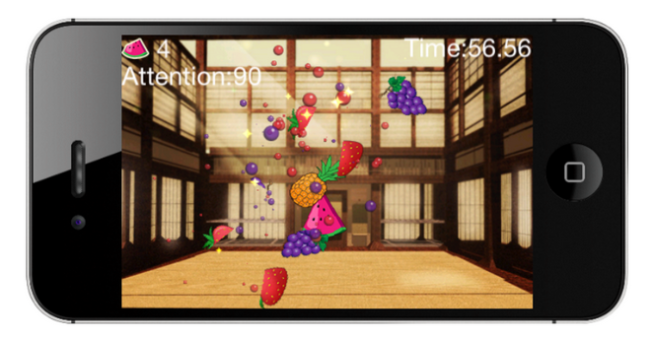
Joselli et al. (2014) presents MindNinja, an iOS game that utilizes NeuroSky’s MindWave based on the popular Fruit Ninja by Halfbrick Studios, the “greatest fruit-slicing game in the world.” In the original Fruit Ninja, as fruit is thrown onto the screen, the player swipes their finger across the screen to create a slicing motion, attempting to slice the fruit in half. The player must try to slice all the fruit presented while avoiding accidentally slicing bombs, which are occasionally thrown. In MindNinja, this game mechanic is augmented to include the MindWave by introducing the goal of maintaining high attention (as measured with the MindWave eSense method) during gameplay. If the player’s attention is low, the game screen in MindNinja becomes foggy, making it more difficult to accurately slice on-screen objects. Alternatively, if the player can maintain the highest levels of attention during gameplay, the game objects are presented in slow motion, including the progression of the in-game timer.
Based on survey responses from 11 players (8 males and 3 females ranging in age from 6 to 42 years old) who tested MindNinja (both with and without the MindWave-enabled features), the authors found that utilization of the MindWave to alter both in-game visual and temporal perception enhanced player enjoyment. Few players reported the Mindwave version was more difficult, although it generally took players a bit longer to figure out. Overall, while players reported that wearing the MindWave was somewhat less comfortable than not wearing it, the MindWave version was rated as more fun and recommended compared with the non-MindWave version.
In addition to describing the implementation and results of testing MindNinja, the authors present a nice review of other BCI games. Also, the authors describe an implementation of an engagement measure E = beta/(alpha + theta), which they utilize during their evaluation of MindNinja on players. This task engagement measure, previously introduced by Pope et al. (1995), had also been implemented using a MindWave system by Szafir and Mutlu (2012).
Reference: Joselli, M., Binder, F., Clua, E., & Soluri, E. “MindNinja: Concept, development and evaluation of a mind action game based on EEGs.” Computer Games and Digital Entertainment (SBGAMES), 2014 Brazilian Symposium on. IEEE, 2014. (Link)